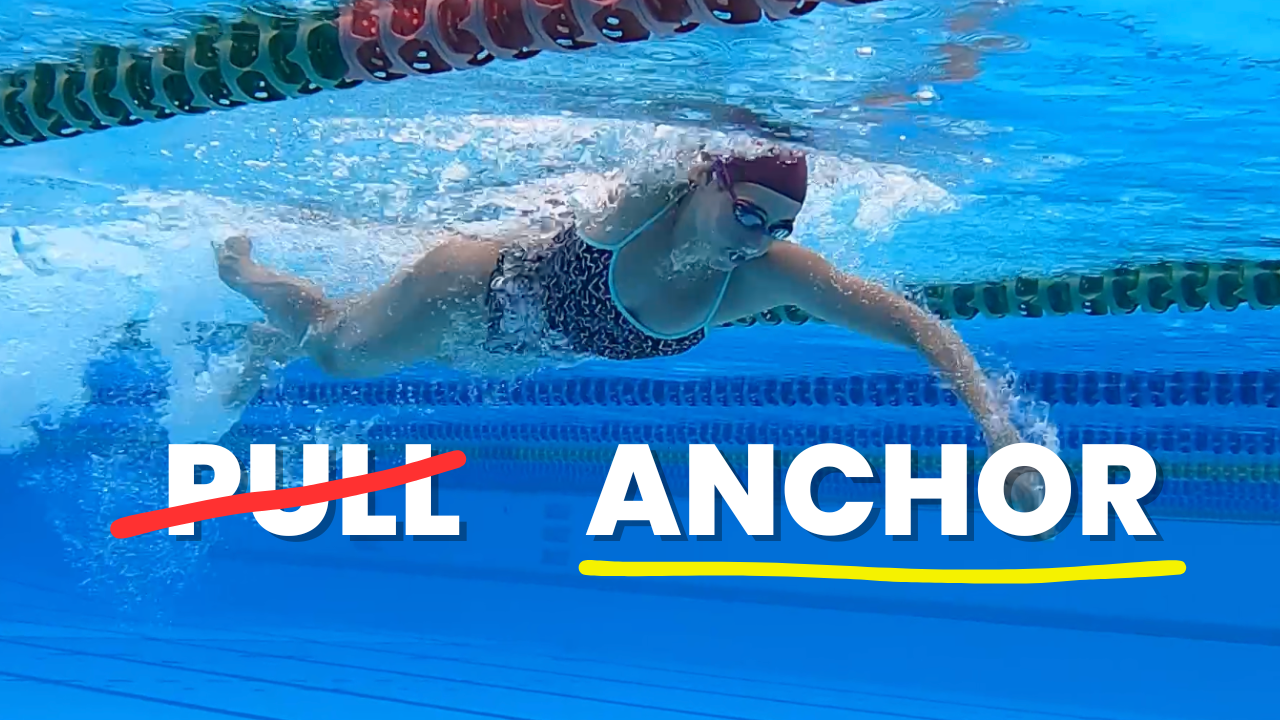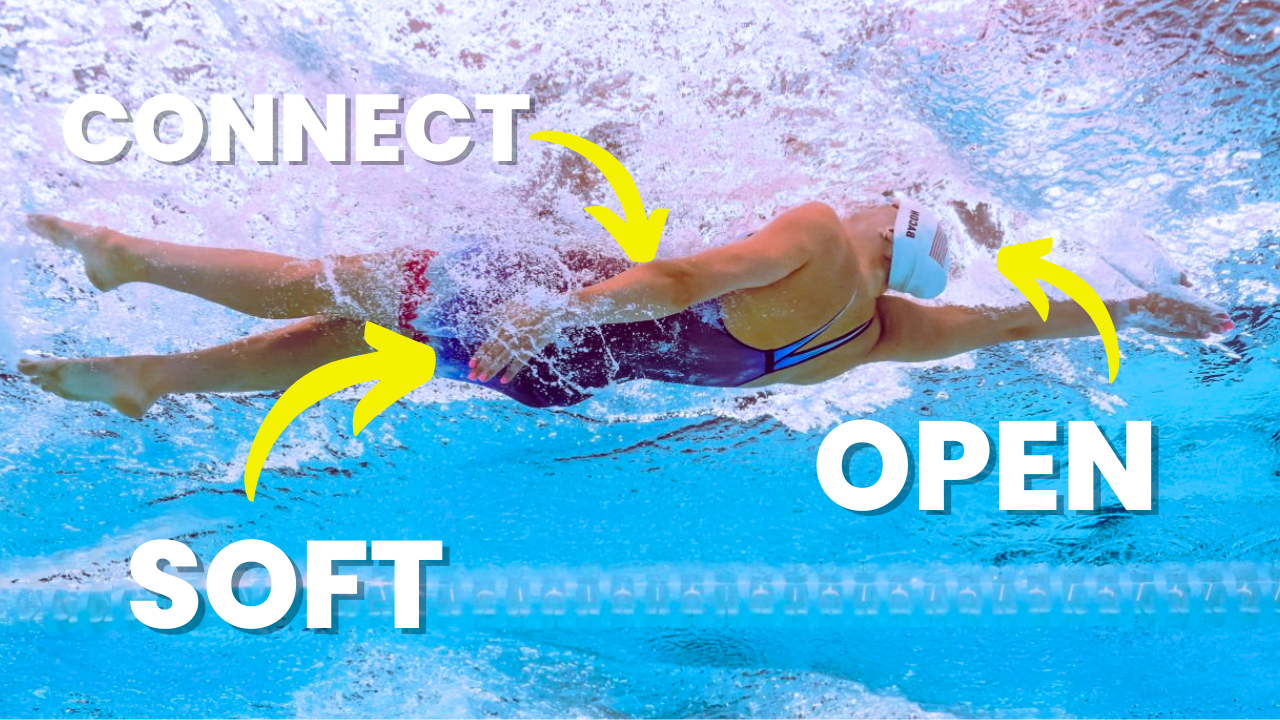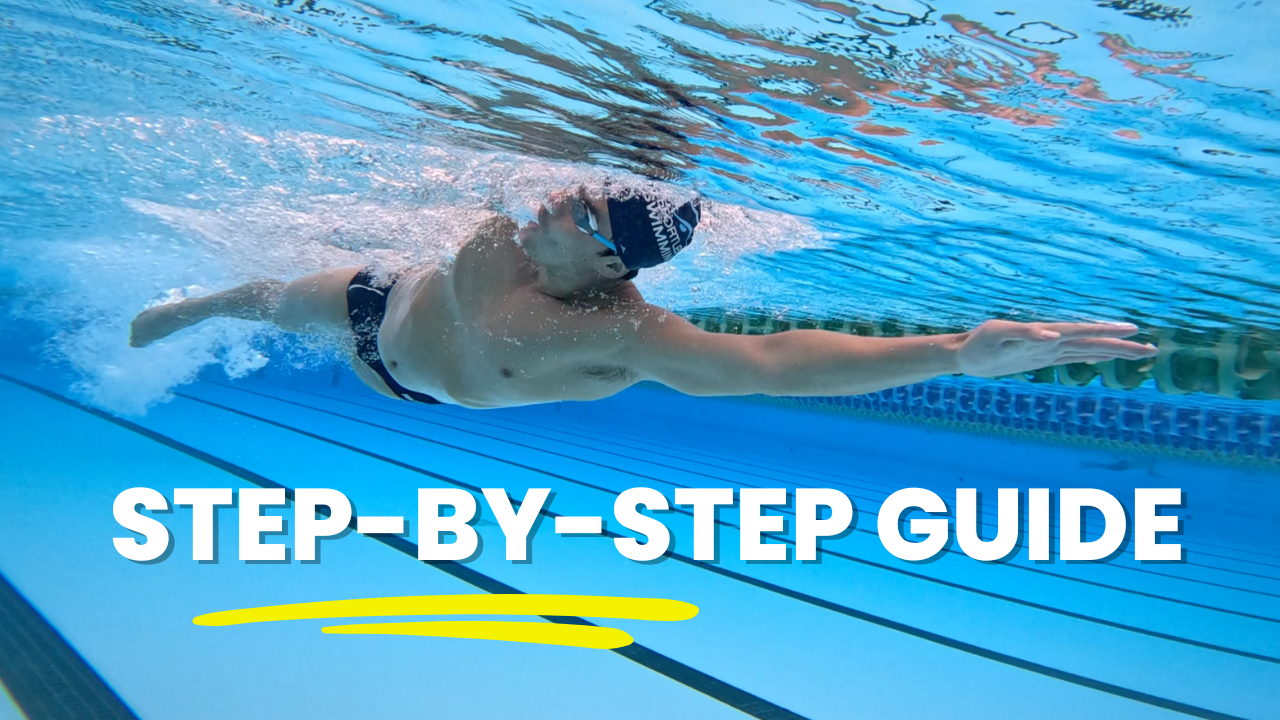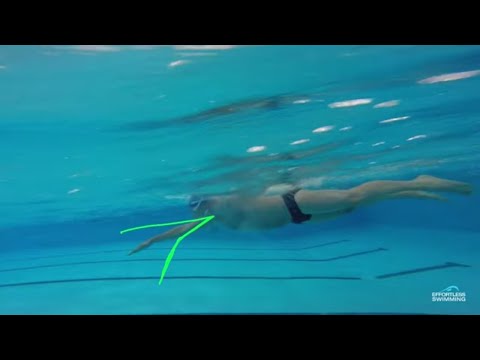To increase the surface that you’re pressing back with and help you with your catch and pull…you might want to consider ‘elevating’ your wrist.
Transcription:
Rather than trying to have that effort come from the hand, or feel like the feel for the water is coming from the hand there, aim for it to be more on the forearm, more in this sort of position, because that’s a much bigger surface area. And if you can maintain that pressure on the forearm through the catch and the pull, as opposed to just the hand, there’s going to be more surface area, and you’ll probably find it’s a bit more of an effective way to approach that part of your stroke.
Hi, Brenton here from Effortless Swimming. In today’s video I want to talk about what you should do with your hand and your forearm and how it relates to your wrist position, and why it’s really important in freestyle, and all the other strikes as well, but particularly in freestyle to elevate the wrist. You might have heard of it as tilting the wrist, but the way I like to refer to it is elevating the wrist. So when I was taught growing up, one of the things or one of the phrases that got mentioned was you should always elevate the wrist in freestyle. Now, it’s a bit of a confusing term, what does that mean? Well, all it basically means is for you to have or maintain the maximum surface area with your hand and your forearm pressing back against the water, you need to elevate your wrist.
Now, what that relates to is this position here. So if you were to drop the wrist, it would look a little bit like this, where the hand has come back from the wrist there. In terms of surface area, pressing back, then it’s going to really half it, it’s going to either give you just this or just this pressing back against the water. But if we want to try and maximize it, then for you to have your hand and forearm together as one big paddle, you’re going to have to elevate the wrist. So all that means is you want to just pop this wrist up slightly, have the hand angle slightly downwards from your forearm there, and that will give you much more surface area than if you were to drop the wrist.
Now, quite often we’ll see, soon as when we’re doing underwater filming at clinics and online, we often see people bending their wrist too much. They might be like this, that’s too much wrist bend, or they go the other way where they actually let the hand and the fingers come back in that position there, especially when they’re reaching and extending forwards. So through about 90% of the stroke, you should be keeping your hand and forearm together as this one big paddle with a slightly elevated wrist instead of a dropped wrist there. The only place where it really changes, sometimes in recovery, it might bend a little bit more, and through the very last part of the stroke, it will sometimes change there as well as the hand is exiting.
But through the reach, through the catch and through most of the pull, you’re going to maintain that firm and elevated wrist position, and that will give you so much more surface area to press back with. Now, what we normally find here is that people think that they’re doing that, but when we actually look at them on film, we see that quite often that’s not the case. They’re either bending their wrist too much in either direction there. So the first thing to do to check whether or not you’re doing this is either to film yourself or to look forward through your reach, your catch, and your pull phase and just actually see if the hand is bending backwards or bending too much at the wrist there. That’s the first step.
Now, if you do see that that’s the case, that you’re not in the right position, there’s a couple of ways that you can start to develop this in your stroke and make that change. Now, a factor in this is certainly strength through your hands, through your forearms. Now, if you don’t do any weights, if you don’t have any strength and conditioning or you don’t have much of swimming background, there’s a good chance that you may not have the strength in your forearms to maintain that pressure on the hand and forearm. So a really good way to develop this without doing strength and conditioning or without doing any weights is sculling, and you’ve probably all seen sculling before.
It can be front scull, it can be top to bottom scull or any kind of scull will help develop this. But if you do a couple of 50s of scull in most of your sessions, you are going to find that your hands and your forearms are going to burn, even 100 meters of scull with a pull buoy between your legs [inaudible 00:00:03:57], you’re going to feel it. Now, if you do that three times, four times within a training session, you are going to really develop your hand and forearm strength to be able to maintain the pressure on the hand and forearm through the catch and the pull there. So a lot of times people just don’t have the strength in that position there to be able to maintain it through their stroke. So that’s the second thing you need to do.
So first of all, see if it’s something you need to change. Secondly, develop the strength to be able to maintain that position, especially when you get tired and especially three, four kilometers into a training session. So sculling can be the best way to develop that strength. Now, another drill that I really like that can help you develop this in probably the most important part of the stroke, which is the catch phase of the stroke is doggy scoop drill, and you’ve probably seen this in some of our videos before. Doggy scoop drill is where we isolate the catch, all we’re focused on is making sure that we get a good catch position and we’re reaching forwards with our hand in the right position and we’re getting over the top of the stroke there.
So in doggy scoop drill, that’s probably the best drill that you can do to make sure that you maintain that hand and forearm as one big paddle through the reach and through the catch phase of the stroke there. So you can have a look at that video right here, and that is one that I really recommend to most people, because the catch and the pull, that’s where most people are going to find that increase in propulsion and find themselves swimming faster. Now, like with any kind of thing in swimming, we don’t want to go too far one way. So if you’re trying to maintain this elevated wrist position, but you’re really, really tense through your hand and through your forearm, you’re going to be wasting effort and energy.
So the way I like to explain this stuff, the way I sort of picture it is you want to have the bare minimum amount of tension within your hand and your forearm to hold the shape, but then you want to relax from there. You need enough tension to hold the form and the shape to it, but then relax from there. So if you’re just like this and it’s very, very tense, and you’re trying to do that for more than 200 meters, you’re going tire, and it’s going to be wasted effort. The same thing goes with the tension and the tautness that we talk about through your midsection, through your core. If you’re really trying to muscle that, you’re not going to be able to hold it for long. So there’s a lot of dichotomies in swimming. We need tension, but we also need to stay relaxed, and that’s probably one of the major ones.
So as you’re doing this, don’t overdo that tension in order to maintain this one paddle hand and forearm position. And one of the phrases that I really like is keeping soft hands. I got this from Wayne Goldsmith who you’ve probably heard on our podcast before. Click the link below. We’ve got a link to our podcast if you’re not subscribed to it yet on iTunes. Wayne Goldsmith talks about … He came and ran a clinic with a group that I was coaching, and he talks about keeping soft hands. So again, if you’re tense, fingers are really close together, then it’s going to be difficult to develop that feel for the water, and it’s going to be wasted effort and energy. So soft hands, but it also means enough tension to hold the form there.
Now, when it comes to your catch and your pull and maintaining this position, a really good way to think about this is trying to keep that pressure on the forearm. So if you saw our recent feedback Friday video that our coach, Mitch Patterson did, one of the things he mentioned there was as you’re going through the catch and through the pull, rather than trying to have that effort come from the hand or feel like the feel for the water is coming from the hand there, aim for it to be more on the forearm, more in this sort of position, because that’s a much bigger surface area. And if you can maintain that pressure on the forearm through the catch and the pull, as opposed to just the hand, it’s going to be more surface area, and you’ll probably find it’s a bit more of an effective way to approach that part of your stroke.
So while we want to maintain this elevated wrist position, think about keeping that pressure and that feel for the water on the forearm instead of the hand. It can be one of those ideas that’s a small change, but it can make a big difference when it comes to getting in the water and trying something new. So if you go to the pool today or go to the pool tomorrow, try that out. Go through some 100s or some 200s, feel like you’re pulling more from the hand, see if it makes a difference compared to if you’re pulling through with what feels like more of the forearm.
And that’s a really good way to test this stuff out because one of the things I get all the time from people is that … We talk about a lot of ideas here, and if you’re going to the pool and you’re trying 20 different things within a week, and you’re not sure what you actually need to focus on, then you are probably going to be trying a lot of different things without really focusing in on the things that will make a difference for you. Now, obviously, if you’re coming to a clinic, if you’ve done online coaching with us, then you know those things that you need to do. But if you don’t have the opportunity to do that or you haven’t done it, then what I recommend is pick one or two things that you know or you’re pretty certain is going to make a difference for you, and then focusing on that.
It might be for four, five, six weeks, it might be even longer than that. But don’t try everything that we mentioned, just focus in on the thing that you think is going to make the difference there. So this can be one of those things that can make a big difference, especially for the swimmers who are really trying to muscle their way through the water by trying to have a lot of that effort or a lot of that pressure come from just the hand. So see if it makes a difference when you go to the pool next. Think of it as your forearm pulling through as opposed to your hand.
Now, the other idea that I like with this, and we do talk about this quite a bit, but I think it’s really important, is you want to gently accelerate through the pull. So if you’re starting out really, really fast and really hard in your catch phase of the stroke, there’s a good chance you’re just going to slip through the water and your elbow will probably drop, it’d be less surface area pressing back. Instead, if you think of the catch as the setup phase, and you are gradually and gently accelerating through the pull, you’re going to be able to maintain that pressure on the hand and forearm and move forwards a lot better that way.
So if you go to the pool next, that can be a good contrast reel to do, where you’re swimming, see if you can pull really fast at the start, and notice what happens with your general feel for the water and also your speed, and then make that shift to a more gradual increase in pressure and power throughout that stroke. And that is a much, much more effective way to move through the water, gentle acceleration through the stroke.
If you know someone who’s looking to improve their swimming, make sure you share this video with them. Like the video and subscribe, it helps us reach out to more people. And if you are looking to get coaching yourself or you want to access all of our courses, all of our drills, all of our workouts, it’s inside out effortless swimming video membership. So check out the link below. It’s currently $55 a year. It will be going up very soon in price, so make sure you check that out. And if you do enjoy these videos, then there’s a lot more content. It’s well organized, and it’s a really simple way, and a step by step process to improve your swimming. So go and check out the Effortless Swimming Video Membership. We’ll be back next week with another video. Looking forward to seeing you then.









